 W
WThe history of lions in Europe is based on fossils of Pleistocene and Holocene lions excavated in Europe since the early 19th century. The first lion fossil was excavated in southern Germany and described by Georg August Goldfuss using the scientific name Felis spelaea, which probably dates to the Würm glaciation and is 191,000 to 57,000 years old. Older lion skull fragments were excavated in Germany and described by Wilhelm von Reichenau under Felis fossilis in 1906. These are estimated at between 621,000 and 533,000 years old. The modern lion inhabited parts of Southern Europe since the early Holocene. Its diet probably included aurochs, red deer, tarpan, wild boar and other herbivores.
 W
WAdapis is an extinct genus of Adapidae primate belonging to the subfamily Adapinae. The genus was named by Cuvier in 1821 and contains up to three species. Males were larger than females.
 W
WThe aurochs, also known as urus or ure, is an extinct species of large wild cattle that inhabited Asia, Europe, and North Africa. It is the ancestor of domestic cattle. The species survived in Europe until 1627, when the last recorded aurochs died in the Jaktorów Forest, Poland.
 W
WThe Balearic shrew is an extinct species of shrew from Majorca and Menorca, in the Balearic Islands of Spain, belonging to the endemic genus Nesiotites. It was one of three native land mammals to the Balearic Islands, alongside Myotragus and Hypnomys. Nesotites has been present in the Balearic Islands for over 5 million years since the Late Miocene-Early Pliocene, and is the final and largest chronospecies of the lineage. It was relatively large for a shrew, being estimated to weigh between 20 to 30 grams. Among living shrews it is most closely related to the Himalayan shrew, from which it diverged around 6.44 million years ago and has a probable close relationship with the extinct genus Asoriculus of mainland Europe and Corsica-Sardinia.
 W
WBustylus is an extinct genus of eutherians in the family Adapisoriculidae. It was described by Emmanuel Gheerbrandt and Russell in 1991, and the type species is B. cernaysi, described from the late Paleocene of Cernay, France, and possibly also from Germany. Gheerbrandt later redescribed the species Peradectes marandati as a species of Bustylus. A third species, B. folieae, was described from the early Paleocene of Belgium by Eric De Bast, Bernard Sigé and Thierry Smith in 2012. B. folieae was named in honour of Dr. Annelise Folie.
 W
WCantius is a genus of adapiform primate that lived in North America and Europe during the early Eocene.
 W
WThe Caucasian moose, also known as the Caucasian elk was a subspecies of moose found in the Caucasus Mountains of Eastern Europe and Asia Minor. It is widely believed to be extinct.
 W
WThe Caucasian wisent or dombay (домбай) was a subspecies of European bison that inhabited the Caucasus Mountains of Eastern Europe.
 W
WChoneziphius is an extinct genus of ziphiidae cetaceans, with two species known from the Miocene: C. planirostris and C. leidyi.
 W
WThe Corsican giant shrew is an extinct shrew from the island of Corsica.
 W
WThe Cyprus dwarf hippopotamus or Cypriot pygmy hippopotamus is an extinct species of hippopotamus that inhabited the island of Cyprus until the early Holocene.
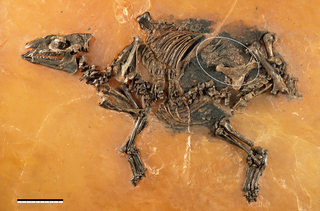 W
WEurohippus is an extinct genus of equid ungulate. Its species were long considered part of Propalaeotherium and Lophiotherium. A pregnant specimen was described in 2015.
 W
WThe European wild ass or hydruntine is an extinct equine from the Middle Pleistocene to Late Holocene of Western Eurasia. It appeared first in the fossil record around 350-300,000 years before present. In the late Pleistocene it was widespread throughout much of western Eurasia from the Middle East to Europe, especially along the Mediterranean, with fossil reports from Sicily, Turkey, Spain, France and Portugal. In the east the range apparently stretched at least to the Volga and to Iran. In the north it reached almost to the North Sea in Germany and the British Isles. Its range fragmented after the Last Glacial Maxiumum, surviving into the Holocene, its range gradually contracted further, persisting in small regions of southern Europe into the Bronze age, and in Iran and the Caucasus into the Iron Age, around 500 BC. It has been suggested that the Iberian Zebro, extinct in the wild from the 16th century, could correspond to the Equus hydruntinus, although the word "zebro" or "cebro" comes from Latin equiferus meaning 'wild horse'. Later research judged that it was unlikely that hydruntines persisted in the Iberian Peninsula beyond the Chalcolithic.
 W
WThe grice was a breed of swine found in the Highlands and Islands of Scotland and in Ireland. It became extinct, surviving longest in the Shetland Isles, where it disappeared sometime between the middle of the 19th century and the 1930s. It was also known as the Highland, Hebridean or Irish pig.
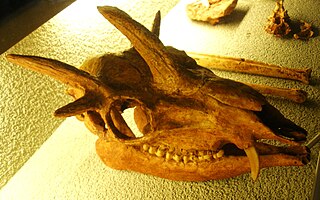 W
WHoplitomeryx is a genus of extinct deer-like ruminants which lived on the former Gargano Island during the Miocene and the Early Pliocene, now a peninsula on the east coast of South Italy. Hoplitomeryx, also known as "prongdeer", had five horns and sabre-like upper canines similar to a modern musk deer.
 W
WKogaionon is a mammal genus from the Upper Cretaceous of Romania. It lived in Transylvania the same time as some of the last non-avian dinosaurs and was a member of the extinct order of Multituberculata. It was named after Kogaionon, the holy mountain of the ancient Dacians. It lies within the suborder Cimolodonta and the family Kogaionidae. The genus Kogaionon was named by Rădulescu R. and Samson P. in 1996.
 W
WLeithia is a genus of extinct giant dormice from the Mediterranean islands of Malta and Sicily. It is considered an example of island gigantism. Leithia melitensis is the largest known species of dormouse, living or extinct, being twice the size of any other known species.
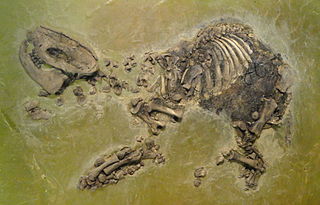 W
WLophiodon is an extinct genus of mammal related to tapirs. It lived in Eocene Europe, and is closely related to Hyrachyus.
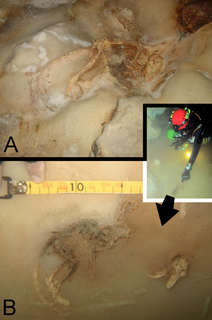 W
WThe Majorcan giant dormouse is an extinct animal from the Balearic Islands of Majorca and Mallorca, Spain. It is considered an example of island gigantism. The closest extant relative is considered to be the genus Eliomys, which includes the garden dormouse, which was confirmed by a mitochondrial DNA analysis in 2020. It is believed to have been omnivorous, with a generalist diet and with an ability to eat hard foods. Its limb bones are robust and dissimilar in morphology to extant Gliridae, suggesting an unusual form of locomotion, with the proportions being closest to that of the Gran Canaria giant rat. It may have been terrestrial rather than arboreal, and it has been suggested that it had fossorial capabilities. The arrival of humans on the island is believed to have been a major factor in its extinction. H. morpheus was described by the palaeontologist Dorothea Bate in 1919. A 2011 study estimated its body weight as between 173 and 284 g, with a head and body length of 179 mm and a total body length of 295 mm.
 W
WMiotragocerus, also known as the European eland, is an extinct species of antelope that once lived in Europe in 10 to 8 million years ago. They were most likely browsers, according to their fossilized teeth and jaw shape. They were likely to have lived near bodies of water, such as many antelope species today.
 W
WMitilanotherium is an extinct genus of giraffes from the Pliocene and Pleistocene of Europe.
 W
WThe Portuguese ibex is an extinct subspecies of Spanish ibex that inhabited the north mountainous zones of Portugal, Galicia, Asturias and western Cantabria. In size and colouration it was much like the Spanish animals, though inclining towards brown rather than black markings. Its horns were strikingly different from any of the other Iberian subspecies. They were only half the length of the Pyrenean ibex, but were almost twice as wide, and, consequently, much closer together at their base.
 W
WProlagus oeningensis is an extinct lagomorph and the type species of its genus, Prolagus. It lived from 15.97 to 7.75 Ma, existing for about 8 million years.
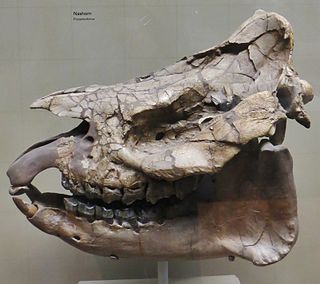 W
WProsantorhinus is an extinct genus of rhinoceros from the lower and middle Miocene. The small teleoceratine rhinocerotid was found in western Europe and Asia, and resembled a hippopotamus in form.
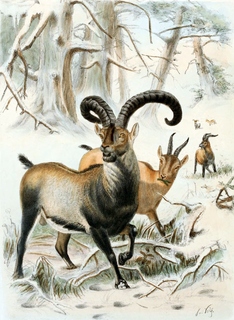 W
WThe Pyrenean ibex, Aragonese and Spanish common name bucardo, Catalan common name herc and French common name bouquetin was one of the four subspecies of the Iberian ibex or Iberian wild goat, a species endemic to the Pyrenees. Pyrenean ibex were most common in the Cantabrian Mountains, Southern France, and the northern Pyrenees. This species was common during the Holocene and Upper Pleistocene, during which their morphology, primarily some skulls, of the Pyrenean ibex was found to be larger than other Capra subspecies in southwestern Europe from the same time.
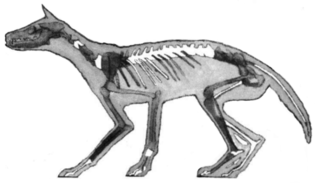 W
WThe Sardinian dhole, also known as the Sardinian fox, is an extinct insular canid which was endemic to what is now the Mediterranean islands of Sardinia (Italy) and Corsica (France), which were joined for much of the Pleistocene. It went extinct when humans began to settle on the island. Its scientific name means "dog-beast of Sardinia", the genus name from the Ancient Greek: θήρ, romanized: thḗr, lit. 'beast', 'wild animal' and κύων, kyōn, 'dog' and the specific name from the Latin: Sardous, lit. 'of Sardinia'.
 W
WThe Sardinian pika is an extinct pika that was native to the islands of Sardinia, Corsica and neighbouring Mediterranean islands until its extinction in the Roman times or perhaps as late as the late 1700s or early 1800s.
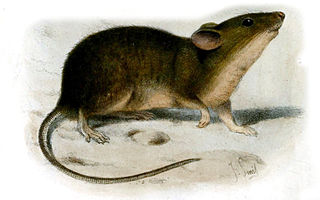 W
WThe St Kilda house mouse is an extinct subspecies of the house mouse found only on the islands of the St Kilda archipelago of northwest Scotland. They were first described, alongside the St Kilda field mouse, by natural historian Gerald Edwin Hamilton Barrett-Hamilton in 1899.
 W
WSunnyodon is a genus of tiny, extinct mammal, probably of the Lower Cretaceous. Found in what is now southern England and Denmark, it was a relatively early member of the extinct order of Multituberculata. It is part of the suborder Plagiaulacida and family Paulchoffatiidae.
 W
WThe tarpan, also known as Eurasian wild horse, is an extinct subspecies of wild horse. The last individual believed to be of this subspecies died in captivity in the Russian Empire during 1909, although some sources claim that it was not a genuine wild horse due to its resemblance to domesticated horses.
 W
WThe Tyrrhenian mole is an extinct species of mammal in the family Talpidae. It was endemic to the Mediterranean islands of Corsica and Sardinia during the Pleistocene epoch.
 W
WThe woolly mammoth is an extinct species of mammoth that lived during the Pleistocene until its extinction in the Holocene epoch. It was one of the last in a line of mammoth species, beginning with Mammuthus subplanifrons in the early Pliocene. The woolly mammoth began to diverge from the steppe mammoth about 800,000 years ago in East Asia. Its closest extant relative is the Asian elephant. The appearance and behaviour of this species are among the best studied of any prehistoric animal because of the discovery of frozen carcasses in Siberia and Alaska, as well as skeletons, teeth, stomach contents, dung, and depiction from life in prehistoric cave paintings. Mammoth remains had long been known in Asia before they became known to Europeans in the 17th century. The origin of these remains was long a matter of debate, and often explained as being remains of legendary creatures. The mammoth was identified as an extinct species of elephant by Georges Cuvier in 1796.
 W
WXiphiacetus is an extinct genus of cetacean known from the Miocene (early Burdigalian to late Tortonian, 20.43 to 7.246 million years ago of Europe and the U.S. East Coast.